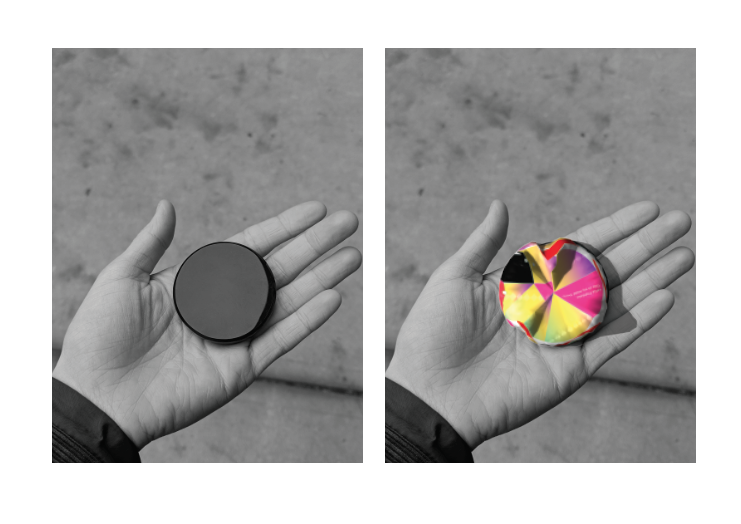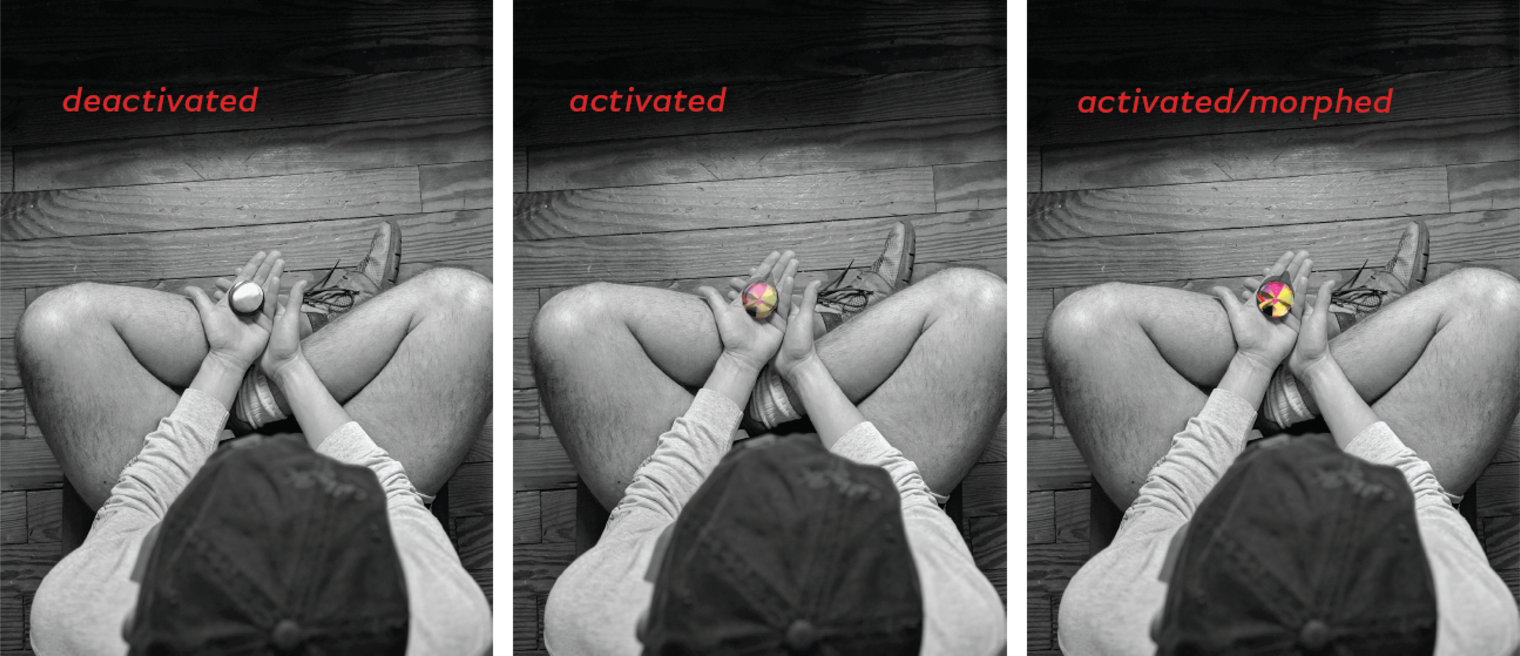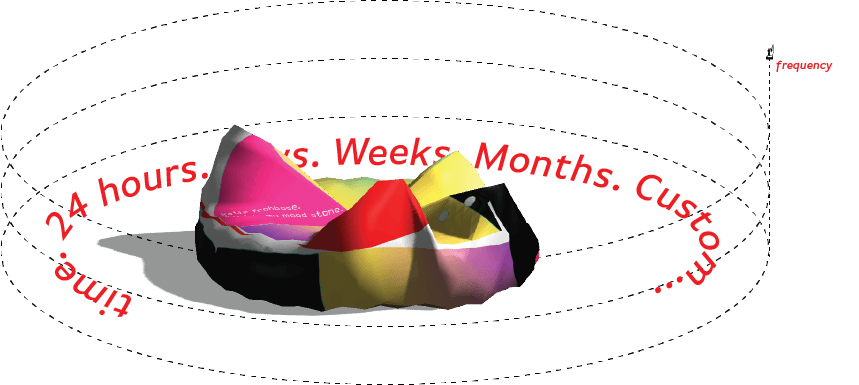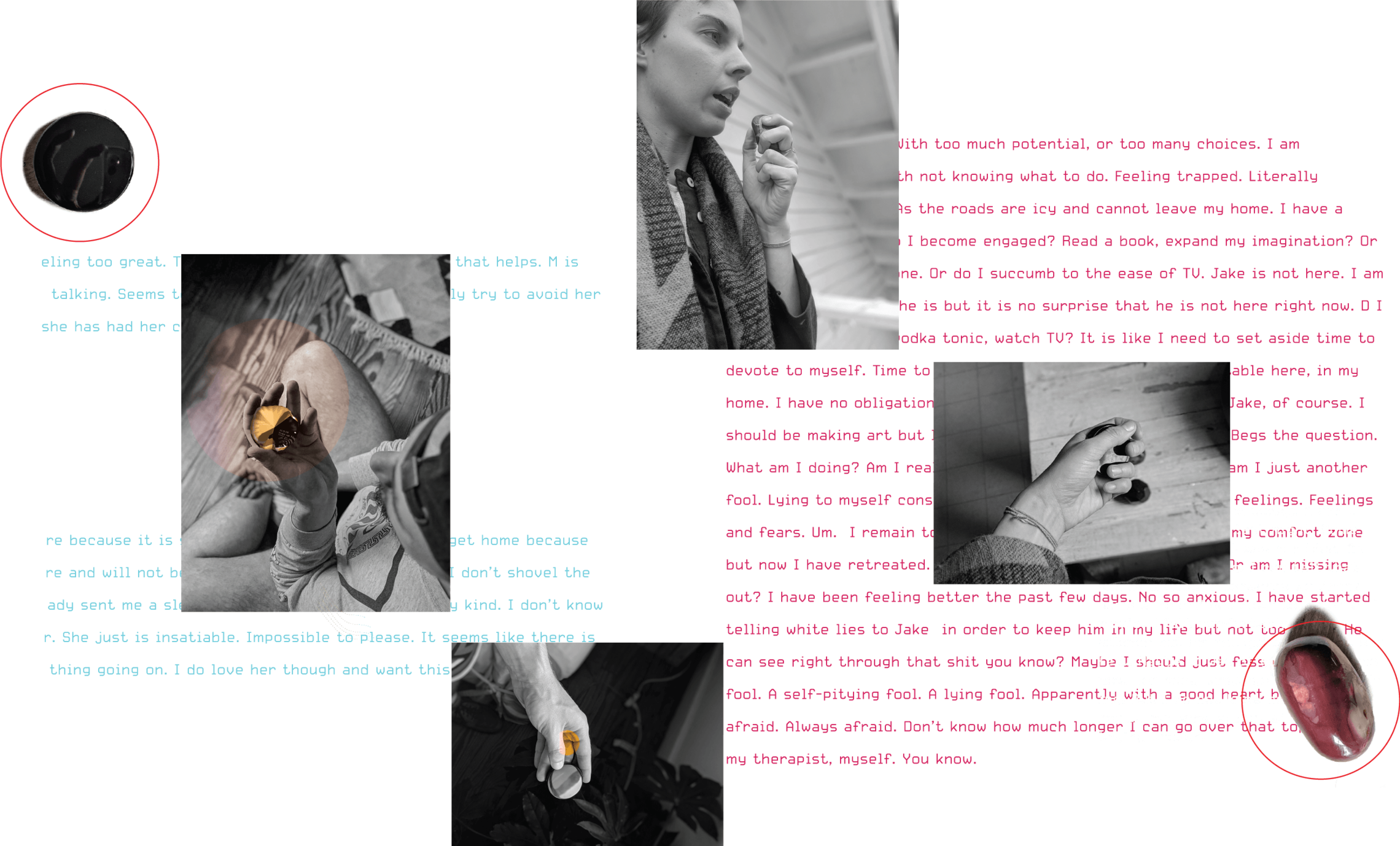Tangible Data

The Soft Stone
In our fall 2018 studio, teams of students led seven workshops that explored a topic of AIGA's Designer 2025. Each workshop resulted in a visual product and as a whole culminated in a group exhibition. We then took a deep dive into individual areas of interest. I focused on the aggregation, curation, and visualization of data and developed the concept for a mutable hand held device, The Soft Stone.
UX Design
Speculative Design
Data Physization
What is it?
The Soft Stone is a soft robotic device that can deliver haptic feedback to a user for the purpose of human assistance and mental health.

How does it work?
The stone aggregates the users data through touch and voice. The types of touch are kinesthetic and tactile. Kinesthetic touch requires the user to consciously activate the device by squeezing or tapping. Tactile devices records ambient information from touch with the skin (such as wearables like the fitbit). In addition to touch, the device has a sensor that records the users voice upon activation.

As the stone activates, it changes color and form.
In its deactivated state the device is a solid with a smooth texture and resembles a crystal, rock, or palmstone. Once activated by touch or voice, the the topography of the stone shifts and morphs as a whole: the stone retains its relative shape but is altered through a material means, as it now has organic bumps with smooth soft surfaces. The stone also changes color through an ambient glow. These changes in form and color indicate changes in data that are representative of the user’s mental health indicated by their touch and voice. The stone is to serve as a physical representation of such data as well as a auditory journal.

What kind of Data?
The database which collectes the user’s information is connected to the stone as well as an online interface (iphone, ipad app and website). The user is able to go into the app and view archived transcribed journal entries and information on the amount of time they squeeze, tap, or rub the rock. Data shows the level of their anxiety (determined by how much they physically interact with the rock) and words to go along with it (through their journal entries). The important thing is that there is a physical and digital representation of the user’s data. Multiple modalities allow for multiple layers of understanding and reflection.



Why a stone and not a phone?
The stone gives the user a sense of digital disconnection through its grounding, physical, and talismanic properties. It’s simple interface eliminates phone distractions like texting, checking instagram and facebook, and playing games. In the context of mental health and mindfulness practices, unplugging is good for the mind (Goulding, 2017). The stone has a clear purpose—to record thoughts and depict data. By reducing distractions, the user can focus on those tasks alone. Cool, but why a rock?
The device takes the form of a palmstone which has for centuries, been associated with talismanic healing powers. People carry around stones, crystals, heirlooms, talismans, sobriety chips and prosthesisize their needs and wishes onto them by seeking external affirmations and reminders (Healy, 2016). An intention of this digital palmstone is to enable this prosthesis.
By resembling a crystalline form, the stone renders the user’s data as physical and organic. Rather than looking at data as discrete and abstract i.e. a 2D visualization—the user can touch and feel their data. The embodiment of data in this way: physical, 3D, shape-shifting, and transient reinforces its very nature and provides a haptic layer of understanding (Lupton 2017). The palmstone is a smart device that feels enchanted (Rose, 2014). The stone also fits in the palm of the hand which can bring a sense of control and power over something as vast and scary as “mental health.”
Who would use it? User Journey
Jake and Marie are having serious relationship issues. Though they have been able to in the past, they cannot communicate with eachother. Especially face to face. They started seeing a therapist who suggested that they use the Soft Stone to record their thoughts and mental health status. Each of them have their own stone but also share an account so they can visualize information together.

Because of her daily commute, Marie prefers to use the stone on the go. She keeps it in her pocket and rubs it often. She usually talks while in transit. Jake prefers to use the stone during his morning meditation sessions. He makes sure to speak into the stone for at least 30 minutes each day.


Every two weeks Jake and Marie meet together at their therapists office to exchange data, empathize, and try to find movements of friction in their relationship through syncing the stones up. They make sure to exchange stones so they can physically feel the other person’s thoughts and feelings in attempt to generate empathy and a haptic understanding of each-other.

They also visualize their stones next to each other and overlaid on top of each other through a shared account. This brings up moments of friction and and ease they can reflect on for help in the relationship.

After 6 months of therapy, Jake and Marie have developed a deeper understanding of each other and have gotten past their communication block, triggers, and problems. They will continue to use the stone for personal reflection and as a tool to help their relationship.

Wider Implication

The Soft Stone is a forward thinking design tool to help bridge communication barriers, monitor mental health status, provide a means to archive thoughts seamlessly and unobtrusively, and to use the advantage of IOT and digital systems for reflective thought. All of these capabilities are outlined in trend 1, 2, and 7 in the AIGA 2025 (AIGA, 2018).
The Soft Stone embodies data that is typically hard to conceptualize (transient, ephemeral, non physical thoughts and “feelings:” anxiety, stressors and so forth in a small, physical object that is representative of the natural, organic world. The physical, tactile, and hand held nature of this data bridges a gap between that which is stored in data farms, far away from our conceptual and visual understanding, to something that is capable of being held, owned: We are in a sense reclaiming our data (which are extensions of ourselves) by making it more physical and aligned with our organic nature (Lupton, 2017).
Oftentimes triggers (emotional/trauma) and communication barriers (language/cultural) close the door for any type of information transfer to happen right upfront. When reading about theories of human behavior in Seminar, one thing that stuck out to me is that both diversity of thought and ease of communication is necessary to bring about behavior change—the stone brings about this ease by eliminating the barriers inherent in some face to face interactions. It draws upon the power of real-time capturing of data in what can be an immediate and stream of conscious way (speaking) so the user can get the emotions out with reflective thought, so the user can take time (once emotions have minimized) to view their data in relation to another.
The stone also generates empathy because it is physical and organic (the user can feel the topography of their mind as well as others whe exchanging stones). It also has a mood enhancing and magical qualities through its shape-shifting form and beautiful, ambient colors.
Sources
“Aggregation and Curation.” Designer 2025 trend. AIGA: 2018. www.aiga/org/designer-2025
“Bridging Digital and Physical Experiences.” Designer 2025 trend. AIGA: 2018. www.aiga/org/designer-2025
Culbertson, Heather. Schorr, and Allison M. Okamura. “Haptics: The Present and Future of Artificial
Touch Sensation.” Annual Review of Control, Robotics, and Autonomous Systems. Annual Reviews. 5 Feb. 2018, https://www.annualreviews.org/doi/pdf/10.1146/annurev-control-060117-105043.
Goulding, Thomas. “How Getting Rid of my Smartphone Revolutionised my Life.” Independent. 2 Sep. 2017, https:// www.independent.co.uk/news/long _reads/ smartphone-get-rid-social-media-change-life-online-capitalism-internet-detox-control-a7910066.html
Healy, Margaret. “Wearing Powerful Words and Objects: Healing Prosthetics.” Textual Practice, 30:7,1233-1251, 28 Nov. 2016 http://doi.org/10.1080/0950236X.2016.1229905.
Hollan, Jim, Stornetta, Scott. “Beyond Being There.” Computer Graphics and Cognitive Science Research Groups. New York, NY: ACM, 1992.
“Making Sense in the Data Economy.” Designer 2025 trend. AIGA: 2018. www.aiga/org/designer-2025
Peng, Sirou. “A Wearable Soft Robot with Variable Material Distribution.” Interactive Architecture Lab, 16 Sep. 2018 http:www.siroupeng.com
Rose, David. Enchanted Objects: Innovation, Design, and the Future of Technology. New York, NY: Scribner, 2014.
Skorina, Erik H, Luo, Ming, and Cagdas D. Onal. “A Soft Robotic Wearable Wrist Device for Kinesthetic